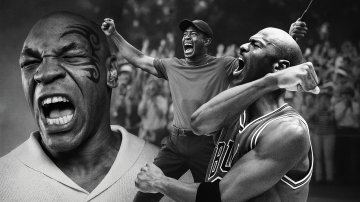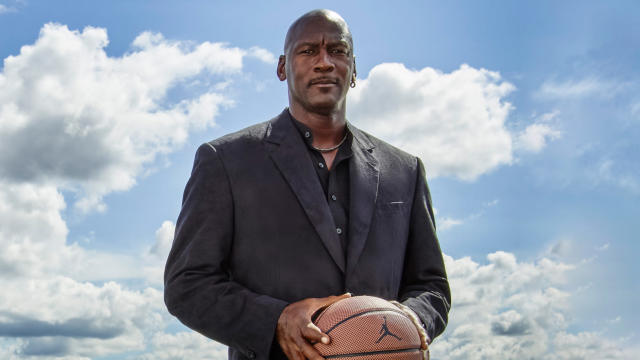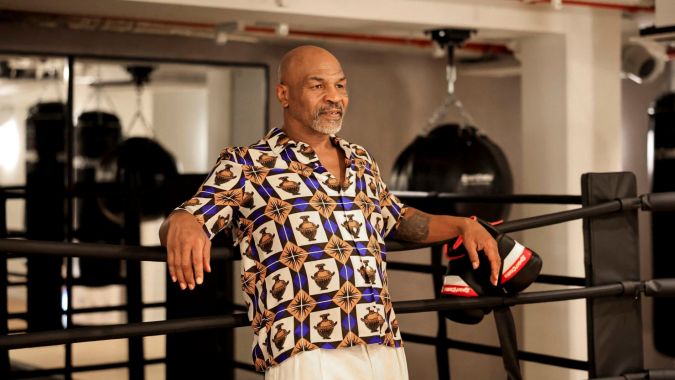Unbreakable: The Athletes Who Refused to Stay Down
The Retreat, Return and Reign of the GOATBY: Eric Lambkins II Let’s cut through the noise, the neon, the mythology

The Retreat, Return and Reign of the GOAT
BY: Eric Lambkins II

Let’s cut through the noise, the neon, the mythology. That crumpled heap of humanity crying on the locker room floor after the ’96 Finals was not His Airness, The Black Cat or Black Jesus. That was Michael. Just Michael. The Carolina kid who’d spent three years running from an empty seat in Section 105.
The 1993 murder of Jordan’s father, James Jordan, stole more than his role model; it stole his gravity. The axis around which Jordan orbited—gone. The culprits: two teenagers and a roadside nap. A life priced at pocket change. And vultures were left circling in the aftermath.
Conspiracies swirled––gambling debts and Shadowy ties. That was hogwash. Bob Costas nailed it: “Not a thimble’s worth of truth.” Nonetheless, the darts landed. Causing Jordan to do the unthinkable: walk away.
Away from the game he loved. Away from the game that revered him. To baseball? Sure. Birmingham bus rides and .202 averages. A surreal, stubborn sidestep. But if you listened closely—you could still hear the squeak of Chicago hardwood haunting him. That, and his father’s voice, tangled with his mother Deloris’ wisdom: “Make negatives into positives, son.”
His Return Wasn’t Graceful. It Was Gritty. Instead of the impenetrable 23 stood No. 45. There was rust in his rotations. He stood naked without his father’s gaze. Orlando bounced ’em in his return. Shaq and Penny’s smirks said it all. So Jordan did what grief demands: he weaponized it.
First ring back? ’96. Father’s Day. Seattle. The collapse. The tears. “This is for Daddy.”
Second? ’97. Flu game. Sweat and sacrifice. A fever dream of devotion.
Third? ’98. The Last Shot. The shrug. The silence where applause should’ve been.
Three titles. Three rebuttals. Three love letters to a ghost.
But here’s what separates Jordan from mere mortals: he understood and grew comfortable in the voids. The court’s emptiness after ’03? He filled it not with nostalgia but nerve.
Air Jordan wasn’t just shoes—it was sovereignty. Billion-dollar moves. Hornets ownership. Apparel empires. Turning Jumpman from a logo into a lexicon. He became the first athlete to crash the Billionaires’ Club. No. He did more. He remodeled the damn clubhouse.
Peer past the lore towards the benevolence. What lies? Quiet checks. Loud impact. Schools. Clinics. Equality battles fought without cameras. Why? Because James once dragged wide-eyed kids to locker rooms, whispering, “See? Hard work matters.” Philanthropy became Michael’s postgame autograph.
And now? NBC’s mic in the broadcast booth. Poetry. Nostalgia. An opportunity to see the game through the master’s eyes. The boy who wept on their airwaves in ’96 will now dissect the game he redefined. Now, a sheathed weapon, he wields the wisdom of a wizard.
So how’d he do it? Simple. Unbearable. He turned absence into architecture. That hollowed-out space where James once sat? Jordan built monuments in it––Championships. Conglomerates. Legacies.
Every fadeaway, every Fortune 500 play, every primetime analysis—has managed to whisper to the same empty seat: “You see this, Pop?”
His success after his father’s murder is not a triumph; it is trigonometry. Trajectories calculated across canyons of grief. And the solution—always, always—was sweat.
The boy soared. The man built. The son? Still searching the stands.
Higher now. Farther. Forever.
Knocked Down, but Not Out
By: Mykell Mathieu

When most people think about professional athletes, they envision the glitz and glamour: the bright lights, the private jets, the impressive statistics, and the championship victories. It’s an extraordinary life—until it all comes to an end.
The average person assumes professional athletes enjoy a typical 5-10 year career before riding off into the sunset to live happily ever after. But that’s rarely the case. Many athletes face tremendous hardships once their competing days are over: financial ruin, broken relationships, substance abuse, and countless other challenges that can devastate those who once seemed invincible.
Boxing legend Mike Tyson’s post-career story exemplifies these struggles.
One of my personal favorite boxers of all time, “Iron Mike” was a professional boxer from 1985 to 2005. He quickly garnered recognition in the boxing world due to his knockout power and, at the age of 20, that power helped him become the youngest heavyweight champion in history by defeating Trevor Berbick for the WBC title.
From that moment on, he became one of the biggest names not only in boxing, but in all of sports. His greatness in the ring and personal controversies outside the ring kept him in the spotlight. At the final bell, he finished his career with 50 wins (44 by knockout), 6 losses, and 2 no contests.
Despite earning over well $300 million during his boxing career, Tyson filed for bankruptcy in 2003, drowning in approximately $23 million of debt. Reckless spending, mismanagement by advisors, costly divorce settlements, and mounting tax obligations had consumed his fortune.
To make matters worse, the former world champion struggled with substance abuse and several personal issues following his fighting career that led to heartbreak and mental health issues.
To some, it seemed as though Tyson would live in darkness until his inevitable end. But, like a prime fighter, he took the punches life handed him and fought back.
Tyson eventually turned his struggles into success. Now he not only speaks out about his struggles, but he uses them to inspire and motivate those who are fighting through similar battles.
The New York City native has made appearances in movies and television shows, he started a cannabis business in 2016 which he calls the “Tyson Ranch” and he stars in a hit podcast called “Hotboxin’ with Mike” where he discusses various topics and interviews guests.
After losing his love for boxing at the end of his career, he returned to the ring in recent years for exhibition fights against the likes of all-time boxing great Roy Jones Jr. and social media sensation, Jake Paul.
Mike Tyson isn’t just a boxing legend, he is a phoenix rising from the ashes! He is the perfect example of continuing to fight in life even when things get tough because one big hit for you can turn things around.
Broken Back, Broken Image—Unbreakable Will: The Tiger Woods Story
By: Jackie Rae

When talent shines so brightly that it breaks through long standing racism and rises to the top, it is impossible not to be considered a legend.
In the pantheon of sports legends, few names shine as brightly—or as complicated—as Eldrick “Tiger” Woods. A prodigy turned icon, Woods redefined golf in the late 1990s and early 2000s, dominating the sport with a mix of power, precision, and poise never before seen. But by 2009, the man who wore red on Sundays seemed to fall harder than anyone thought possible. His comeback, years later, wasn’t just a return to form—it was a resurrection.
At his peak, Woods was untouchable. He won 14 majors between 1997 and 2008, and it seemed inevitable that he would surpass Jack Nicklaus’s record of 18. In his prime he didn’t experience the loss of his father to a senseless crime like Michael Jordan. He didn’t lose his money, or spend three years in jail like Mike Tyson. But, his fall from grace did share a common theme with both — a fall that was a front page scandal.
For Woods, his tabloid-filled scandal did more than just damage his career, it shattered his cookie-cutter “good boy image” that helped him brand the name Tiger Woods.
After his multiple infidelities were exposed, his marriage to Elin Nordegren ended. Corporate sponsors dropped him. The press, once infatuated, turned ruthless. For the first time in his career, Woods didn’t just look human—he looked broken.
Then came the injuries. Back surgeries, knee problems, and recurring pain plagued his body. Between 2014 and 2017, Woods played in just 19 official events. At one point, he was ranked outside the top 1,000 in the world. In 2017, a DUI arrest added to the growing narrative that the Tiger era had ended.
My mother had a saying, “When you think you are too high and mighty, God has a way of humbling you,” she would tell me. “It will always be in the worst way possible. The best you can do is learn from it.”
I can’t say Tiger Woods had a mother who told him the same. But, I can say — he absolutely grew as a person following his fall from grace.
In 2018, after spinal fusion surgery and years of doubt, he showed flashes of brilliance again—finishing second at the PGA Championship and winning the Tour Championship, his first victory in five years. The roar was back, albeit with cautious optimism.
But what happened on April 14, 2019, erased all caution. At the Masters—on golf’s most sacred ground—Tiger Woods won his 15th major title, nearly 11 years after his last. The moment wasn’t just historic—it was emotional. Fans wept. His children, who had never seen him win a major, embraced their father near the 18th green. For once, the story wasn’t about controversy—it was about redemption.
“I had serious doubts after what transpired a couple of years ago,” Woods said following his win as his voice choked with emotion. “I couldn’t walk. I couldn’t play. And now I’m here.”
Woods’ story is no longer just about dominance. It’s about resilience. From public disgrace to physical collapse, his journey has become one of sport’s greatest redemption arcs. His ability to inspire a new generation—particularly Black and multiracial golfers—remains one of his most important contributions.
The 2021 car crash that nearly took his life added yet another chapter to this improbable saga. And still, Tiger fights. He returned to the PGA Tour in 2022 and has played select events since, walking courses many thought he’d never step on again.
His trials, tribulations and rejuvenation transcends records. Tiger Woods has proven that the climb back up, no matter how steep, is what defines greatness.



